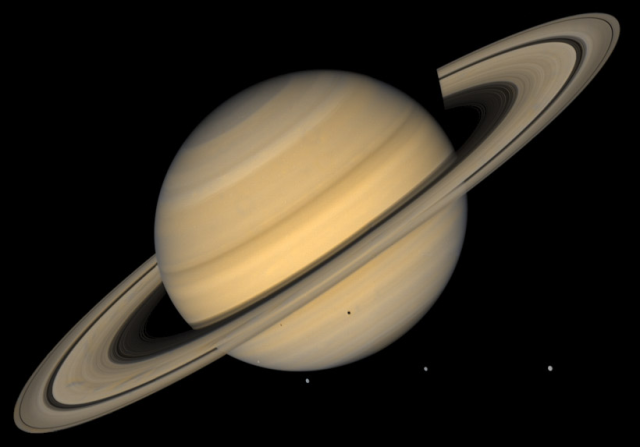
Saturn-watchers take note. Tonight is not only the best time to view the striking ringed planet in 2013, but experts say it's the best chance to get a clear, bright view from an Earth-based telescope in years.
This evening Saturn will stand "at opposition" to the Sun, meaning Earth is sitting almost perfectly in line between the Sun and the sixth planet in our solar system. Saturn will be only about 808 million miles from Earth tonight, making the planet appear as bright as nearby stars such as Betelgeuse. The apparent magnitude will be between 0.1 to 0.3.
Because of the opposition, Saturn will be visible throughout the evening when looking to the southeast, rising in the East and reaching its highest elevation at midnight. The planet will continue to appear in the night sky through much of May, but tonight offers the best viewing opportunity to see Saturn's marvelous rings. Through telescope, you'll also be able to make out many of Saturn's 60 moons, including Titan, Rhea, and Tehtys. Even the hexagonal cloud pattern surrounding its north pole should be visible.
While Saturn goes into opposition every year, this year's opposition presents the best sight opportunity in the last six oppositions, according to Astronomy magazine columnist Bob Berman. The planet's rings will be visible at a tilt of more than 18 degrees, presenting an incredible view of the 30-foot thick disc of rock and ice, as well as the black gap of the Cassini division.
While some viewers can make out the rings around Saturn with their naked eye, most people will need 25x magnification to make them out. A decent pair of binoculars should be enough to get a glimpse but, of course, a telescope with at least 100x magnification would be better. For those with access to neither, the Slooh space camera will be offering a live stream of it all from its observatory in the Canary Islands starting at 6:30 PDT (1:30 UTC). Interested skywatchers can check it out on PC/Mac or through an iPad app, complete with commentary from a panel of astronomy experts.
You'll be able to find Saturn as a golden, non-twinkling point of light just below Spica, a bright star that you can locate by following the curve of the Big Dipper's handle. Check out this viewing guide from EarthSky.org for more details and directions on how to find it in the night sky.

reader comments
43